HSP90 Co-Chaperone, CacyBP/SIP, Protects α-Synuclein from Aggregation
Abstract
:1. Introduction
2. Materials and Methods
2.1. Plasmids
2.2. Proteins
2.3. In Vitro Aggregation ThT Assay and Dot-Blot Analysis
2.4. Transmission Electron Microscopy (TEM)
2.5. Enzyme-Linked Immunosorbent Assay (ELISA)
2.6. Crosslinking Experiment
2.7. Cell Culture and Transfection
2.8. Preparation and Propagation of α-Synuclein Seeds in HEK293 Cells
2.9. Immunofluorescence Staining and Confocal Microscopy
2.10. Proximity Ligation Assay
2.11. Preparation of Protein Lysates from HEK293 Cells
2.12. Cell Viability Analysis
2.13. SDS-PAGE and Western Blot
2.14. Statistical Analysis
3. Results
3.1. Effect of CacyBP/SIP on α-Synuclein Aggregation In Vitro
3.2. Effect of CacyBP/SIP Domains on α-Synuclein Aggregation In Vitro
3.3. Direct Interaction between α-Synuclein and CacyBP/SIP
3.4. Influence of CacyBP/SIP on α-Synuclein Aggregation in HEK293 Cells and Their Viability
4. Discussion
Supplementary Materials
Author Contributions
Funding
Acknowledgments
Conflicts of Interest
Abbreviations
References
- Butler, B.; Sambo, D.; Khoshbouei, H. Alpha-synuclein modulates dopamine neurotransmission. J. Chem. Neuroanat. 2017, 83-84, 41–49. [Google Scholar] [CrossRef] [PubMed]
- Chen, R.H.; Wislet-Gendebien, S.; Samuel, F.; Visanji, N.P.; Zhang, G.; Marsilio, D.; Langman, T.; Fraser, P.E.; Tandon, A. α-Synuclein membrane association is regulated by the Rab3a recycling machinery and presynaptic activity. J. Biol. Chem. 2013, 288, 7438–7449. [Google Scholar] [CrossRef] [PubMed] [Green Version]
- Ganjam, G.K.; Bolte, K.; Matschke, L.A.; Neitemeier, S.; Dolga, A.M.; Höllerhage, M.; Höglinger, G.U.; Adamczyk, A.; Decher, N.; Oertel, W.H.; et al. Mitochondrial damage by α-synuclein causes cell death in human dopaminergic neurons. Cell Death Dis. 2019, 10, 865. [Google Scholar] [CrossRef]
- Rodriguez-Araujo, G.; Nakagami, H.; Hayashi, H.; Mori, M.; Shiuchi, T.; Minokoshi, Y.; Nakaoka, Y.; Takami, Y.; Komuro, I.; Morishita, R.; et al. Alpha-synuclein elicits glucose uptake and utilization in adipocytes through the Gab1/PI3K/Akt transduction pathway. Cell. Mol. Life Sci. 2013, 70, 1123–1133. [Google Scholar] [CrossRef] [PubMed]
- Wang, C.; Zhao, C.; Li, D.; Tian, Z.; Lai, Y.; Diao, J.; Liu, C. Versatile Structures of α-Synuclein. Front. Mol. Neurosci. 2016, 9, 48. [Google Scholar] [CrossRef] [PubMed]
- Chavarría, C.; Rodríguez-Bottero, S.; Quijano, C.; Cassina, P.; Souza, J.M. Impact of monomeric, oligomeric and fibrillar alpha-synuclein on astrocyte reactivity and toxicity to neurons. Biochem. J. 2018, 475, 3153–3169. [Google Scholar] [CrossRef] [PubMed]
- Froula, J.M.; Castellana-Cruz, M.; Anabtawi, N.M.; Camino, J.D.; Chen, S.W.; Thrasher, D.R.; Freire, J.; Yazdi, A.A.; Fleming, S.; Dobson, C.M.; et al. Defining α-synuclein species responsible for Parkinson’s disease phenotypes in mice. J. Biol. Chem. 2019, 294, 10392–10406. [Google Scholar] [CrossRef] [Green Version]
- Wang, X.; Becker, K.; Levine, N.; Zhang, M.; Lieberman, A.P.; Moore, D.J.; Ma, J. Pathogenic alpha-synuclein aggregates preferentially bind to mitochondria and affect cellular respiration. Acta Neuropathol. Commun. 2019, 7, 41. [Google Scholar] [CrossRef]
- Schmidt, F.; Levin, J.; Kamp, F.; Kretzschmar, H.; Giese, A.; Bötzel, K. Single-channel electrophysiology reveals a distinct and uniform pore complex formed by α-synuclein oligomers in lipid membranes. PLoS ONE 2012, 7, e42545. [Google Scholar] [CrossRef] [Green Version]
- Angelova, P.R.; Ludtmann, M.H.; Horrocks, M.H.; Negoda, A.; Cremades, N.; Klenerman, D.; Dobson, C.M.; Wood, N.W.; Pavlov, E.V.; Gandhi, S.; et al. Ca2+ is a key factor in α-synuclein-induced neurotoxicity. J. Cell Sci. 2016, 129, 1792–1801. [Google Scholar] [CrossRef] [Green Version]
- Angot, E.; Steiner, J.A.; Lema Tomé, C.M.; Ekström, P.; Mattsson, B.; Björklund, A.; Brundin, P. Alpha-Synuclein Cell-to-Cell Transfer and Seeding in Grafted Dopaminergic Neurons In Vivo. PLoS ONE 2012, 7, e39465. [Google Scholar] [CrossRef] [PubMed] [Green Version]
- Nizynski, B.; Dzwolak, W.; Nieznanski, K. Amyloidogenesis of Tau protein. Protein Sci. 2017, 26, 2126–2150. [Google Scholar] [CrossRef] [PubMed] [Green Version]
- Teil, M.; Arotcarena, M.L.; Faggiani, E.; Laferriere, F.; Bezard, E.; Dehay, B. Targeting α-synuclein for PD Therapeutics: A Pursuit on All Fronts. Biomolecules 2020, 10, 391. [Google Scholar] [CrossRef] [PubMed] [Green Version]
- Bohush, A.; Bieganowski, P.; Filipek, A. Hsp90 and Its Co-Chaperones in Neurodegenerative Diseases. Int. J. Mol. Sci. 2019, 20, 4976. [Google Scholar] [CrossRef] [Green Version]
- Burmann, B.M.; Gerez, J.A.; Matečko-Burmann, I.; Campioni, S.; Kumari, P.; Ghosh, D.; Mazur, A.; Aspholm, E.E.; Šulskis, D.; Wawrzyniuk, M.; et al. Regulation of α-synuclein by chaperones in mammalian cells. Nature 2020, 577, 127–132. [Google Scholar] [CrossRef]
- Falsone, S.F.; Kungl, A.J.; Rek, A.; Cappai, R.; Zangger, K. The molecular chaperone Hsp90 modulates intermediate steps of amyloid assembly of the Parkinson-related protein alpha-synuclein. J. Biol. Chem. 2009, 284, 31190–31199. [Google Scholar] [CrossRef] [Green Version]
- Daturpalli, S.; Waudby, C.A.; Meehan, S.; Jackson, S.E. Hsp90 inhibits α-synuclein aggregation by interacting with soluble oligomers. J. Mol. Biol. 2013, 425, 4614–4628. [Google Scholar] [CrossRef]
- Bohush, A.; Niewiadomska, G.; Weis, S.; Filipek, A. HSP90 and Its Novel Co-Chaperones, SGT1 and CHP-1, in Brain of Patients with Parkinson’s Disease and Dementia with Lewy Bodies. J. Parkinsons Dis. 2019, 9, 97–107. [Google Scholar] [CrossRef] [Green Version]
- Liu, A.Y.; Lee, Y.K.; Manalo, D.; Huang, L.E. Attenuated heat shock transcriptional response in aging: Molecular mechanism and implication in the biology of aging. In Stress Inducible Cellular Responses; Feige, U., Morimoto, R.I., Polla, B., Eds.; Springer: Basel, Switzerland, 1996; Volume 77, pp. 393–408. [Google Scholar] [CrossRef]
- Góral, A.; Bieganowski, P.; Prus, W.; Krzemień-Ojak, Ł.; Kądziołka, B.; Fabczak, H.; Filipek, A. Calcyclin Binding Protein/Siah-1 Interacting Protein Is a Hsp90 Binding Chaperone. PLoS ONE 2016, 11, e0156507. [Google Scholar] [CrossRef]
- Góral, A.; Bartkowska, K.; Djavadian, R.L.; Filipek, A. CacyBP/SIP, a Hsp90 binding chaperone, in cellular stress response. Int. J. Biochem. Cell Biol. 2018, 99, 178–185. [Google Scholar] [CrossRef]
- Jastrzebska, B.; Filipek, A.; Nowicka, D.; Kaczmarek, L.; Kúznicki, J. Calcyclin (S100A6) binding protein (CacyBP) is highly expressed in brain neurons. J. Histochem. Cytochem. 2000, 48, 1195–1202. [Google Scholar] [CrossRef] [PubMed] [Green Version]
- Bhattacharya, S.; Lee, Y.T.; Michowski, W.; Jastrzebska, B.; Filipek, A.; Kuznicki, J.; Chazin, W.J. The modular structure of SIP facilitates its role in stabilizing multiprotein assemblies. Biochemistry 2005, 44, 9462–9471. [Google Scholar] [CrossRef] [PubMed]
- Iridoy, M.O.; Zubiri, I.; Zelaya, M.V.; Martinez, L.; Ausín, K.; Lachen-Montes, M.; Santamaría, E.; Fernandez-Irigoyen, J.; Jericó, I. Neuroanatomical Quantitative Proteomics Reveals Common Pathogenic Biological Routes between Amyotrophic Lateral Sclerosis (ALS) and Frontotemporal Dementia (FTD). Int. J. Mol. Sci. 2018, 20, 4. [Google Scholar] [CrossRef] [PubMed] [Green Version]
- Czeredys, M.; Gruszczynska-Biegala, J.; Schacht, T.; Methner, A.; Kuznicki, J. Expression of genes encoding the calcium signalosome in cellular and transgenic models of Huntington’s disease. Front. Mol. Neurosci. 2013, 6, 42. [Google Scholar] [CrossRef] [PubMed] [Green Version]
- Lachén-Montes, M.; González-Morales, A.; Iloro, I.; Elortza, I.; Ferrer, I.; Gveric, D.; Fernández-Irigoyen, J.; Santamarí, E. Unveiling the olfactory proteostatic disarrangement in Parkinson’s disease by proteome-wide profiling. Neurobiol. Aging 2019, 73, 123–134. [Google Scholar] [CrossRef] [PubMed]
- Topolska-Woś, A.M.; Shell, S.M.; Kilańczyk, E.; Szczepanowski, R.H.; Chazin, W.J.; Filipek, A. Dimerization and phosphatase activity of calcyclin-binding protein/Siah-1 interacting protein: The influence of oxidative stress. FASEB J. 2015, 29, 1711–1724. [Google Scholar] [CrossRef] [Green Version]
- Hoyer, W.; Antony, T.; Cherny, D.; Heim, G.; Jovin, T.M.; Subramaniam, V. Dependence of alpha-synuclein aggregate morphology on solution conditions. J. Mol. Biol. 2002, 322, 383–393. [Google Scholar] [CrossRef] [Green Version]
- Omran, A. The Effects of Molecular Chaperones on Tau Fibril Assembly. Master’s Thesis, University of Denver, Colombia, CA, USA, 2015. [Google Scholar]
- Laemmli, U.K. Cleavage of Structural Proteins during the Assembly of the Head of Bacteriophage T4. Nature 1970, 227, 680–685. [Google Scholar] [CrossRef]
- Biancalana, M.; Koide, S. Molecular Mechanism of Thioflavin-T Binding to Amyloid Fibrils. Biochim. Biophys. Acta 2010, 1804, 1405–1412. [Google Scholar] [CrossRef] [Green Version]
- Kundel, F.; De, S.; Flagmeier, P.; Horrocks, M.H.; Kjaergaard, M.; Shammas, S.L.; Jackson, S.E.; Dobson, C.M.; Klenerman, D. Hsp70 Inhibits the Nucleation and Elongation of Tau and Sequesters Tau Aggregates with High Affinity. ACS Chem. Biol. 2018, 13, 636–646. [Google Scholar] [CrossRef]
- McCann, H.; Stevens, C.H.; Cartwright, H.; Halliday, G.M. α-Synucleinopathy phenotypes. Parkinsonism Relat. Disord. 2014, S62–S67. [Google Scholar] [CrossRef] [Green Version]
- Witt, S.N. Molecular chaperones, α-synuclein, and neurodegeneration. Mol. Neurobiol. 2013, 47, 552–560. [Google Scholar] [CrossRef] [PubMed] [Green Version]
- Aprile, F.A.; Källstig, E.; Limorenko, G.; Vendruscolo, M.; Ron, D.; Hansen, C. The molecular chaperones DNAJB6 and Hsp70 cooperate to suppress α-synuclein aggregation. Sci. Rep. 2018, 8, 11848. [Google Scholar] [CrossRef] [Green Version]
- Gao, X.; Carroni, M.; Nussbaum-Krammer, C.; Mogk, A.; Nillegoda, N.B.; Szlachcic, A.; Guilbride, D.L.; Saibil, H.R.; Mayer, M.P.; Bukau, B. Human Hsp70 Disaggregase Reverses Parkinson’s-Linked α-Synuclein Amyloid Fibrils. Mol. Cell 2015, 59, 781–793. [Google Scholar] [CrossRef] [PubMed] [Green Version]
- Novoselova, T.V.; Margulis, B.A.; Novoselov, S.S.; Sapozhnikov, A.M.; Spuy, J.; Cheetham, M.E.; Guzhova, I.V. Treatment with extracellular HSP70/HSC70 protein can reduce polyglutamine toxicity and aggregation. J. Neurochem. 2005, 94, 597–606. [Google Scholar] [CrossRef]
- Yamamoto, H.; Fukui, N.; Adachi, M.; Saiki, E.; Yamasaki, A.; Matsumura, R.; Kuroyanagi, D.; Hongo, K.; Mizobata, T.; Kawata, Y. Human Molecular Chaperone Hsp60 and Its Apical Domain Suppress Amyloid Fibril Formation of α-Synuclein. Int. J. Mol. Sci. 2019, 21, 47. [Google Scholar] [CrossRef] [Green Version]
- Park, S.K.; Arslan, F.; Kanneganti, V.; Barmada, S.J.; Purushothaman, P.; Verma, S.C.; Liebmana, S.W. Overexpression of a conserved HSP40 chaperone reduces toxicity of several neurodegenerative disease proteins. Prion 2018, 12, 16–22. [Google Scholar] [CrossRef]
- Cox, D.; Ecroyd, H. The small heat shock proteins αB-crystallin (HSPB5) and Hsp27 (HSPB1) inhibit the intracellular aggregation of α-synuclein. Cell Stress Chaperones 2018, 22, 589–600. [Google Scholar] [CrossRef] [Green Version]
- Sherer, T.B.; Betarbet, R.; Testa, C.M.; Seo, B.B.; Richardson, J.R.; Kim, J.H.; Miller, G.W.; Yagi, T.; Matsuno-Yagi, A.; Greenamyre, J.T. Mechanism of toxicity in rotenone models of Parkinson’s disease. J. Neurosci. 2003, 23, 10756–10764. [Google Scholar] [CrossRef]
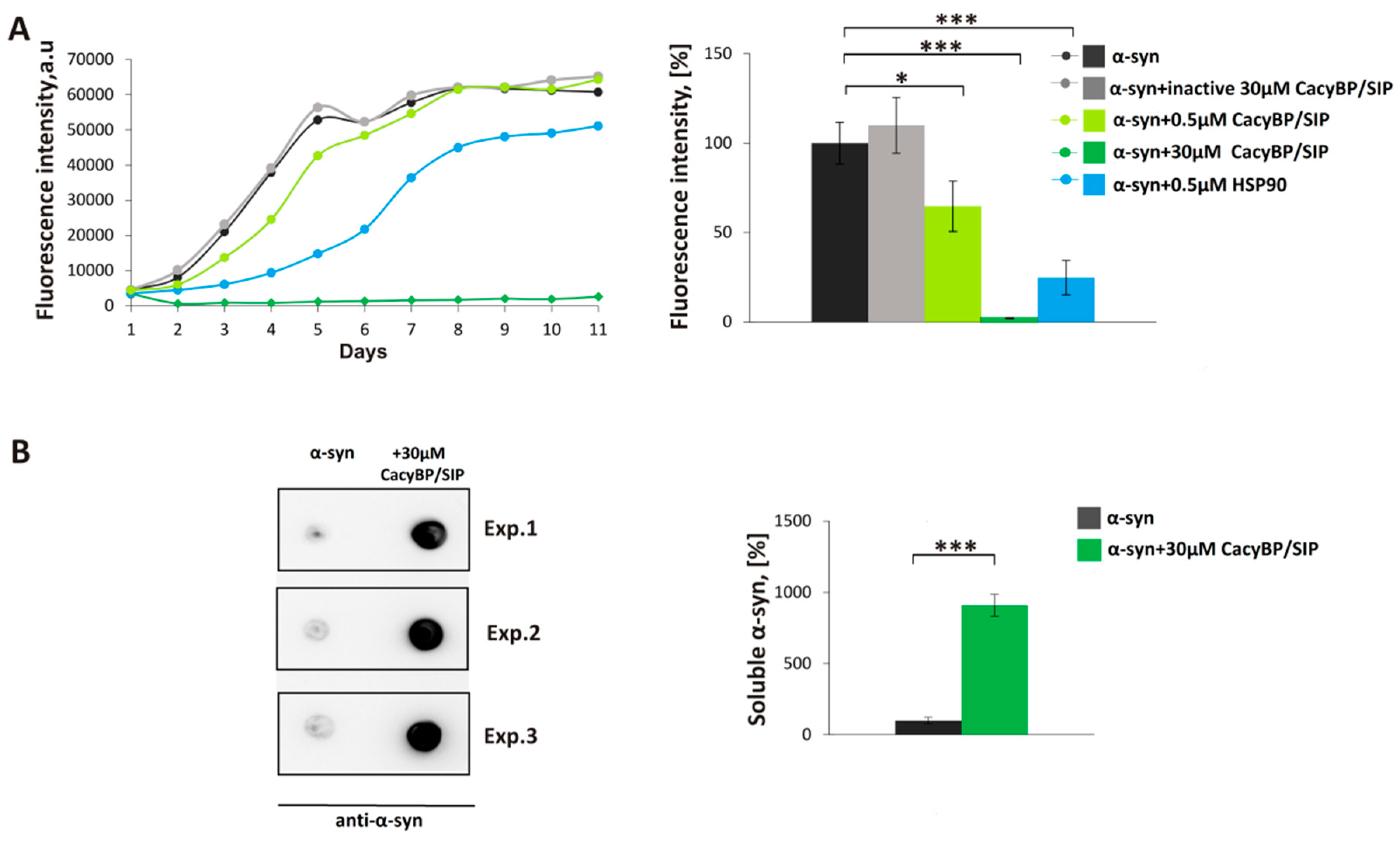
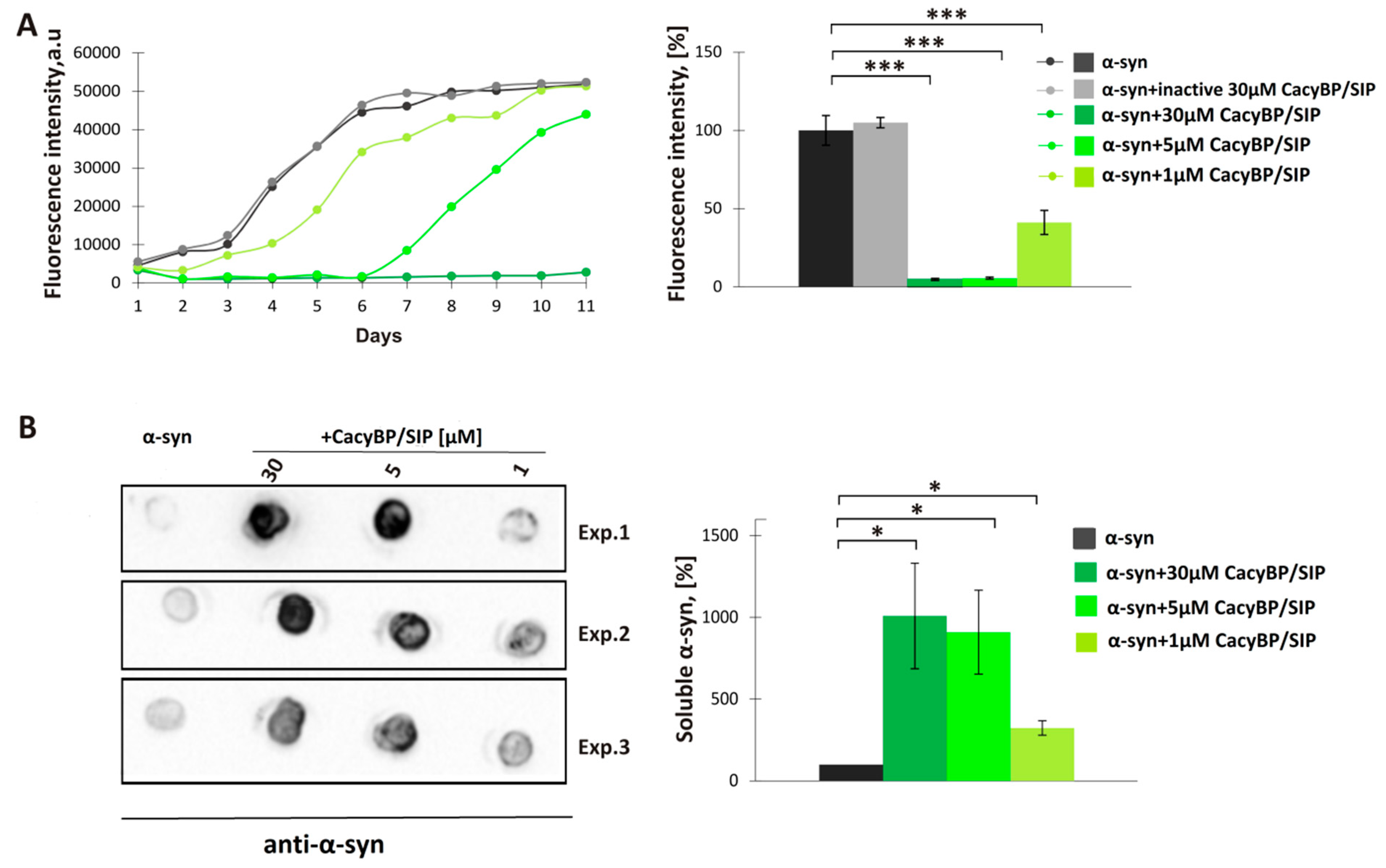

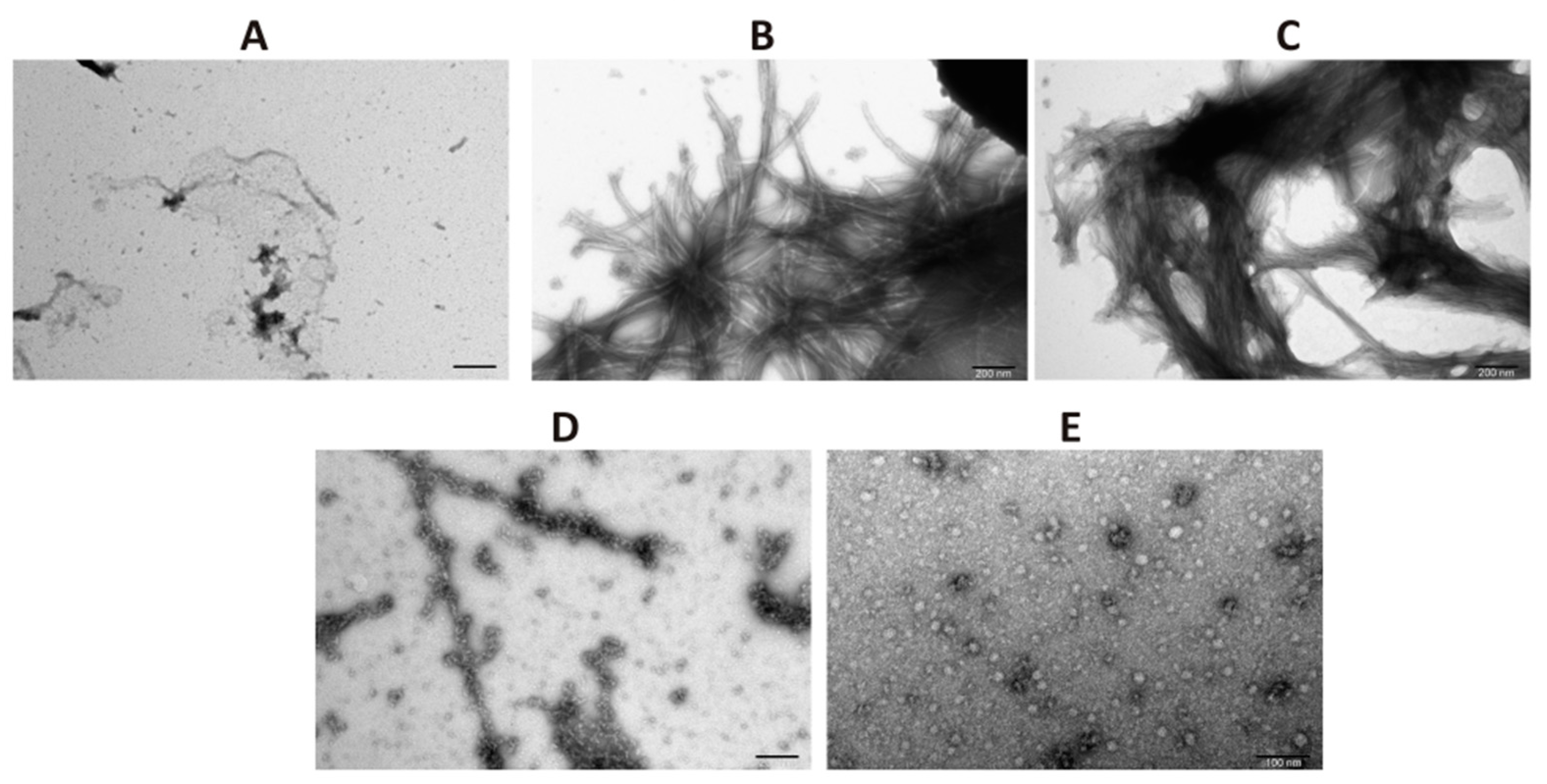

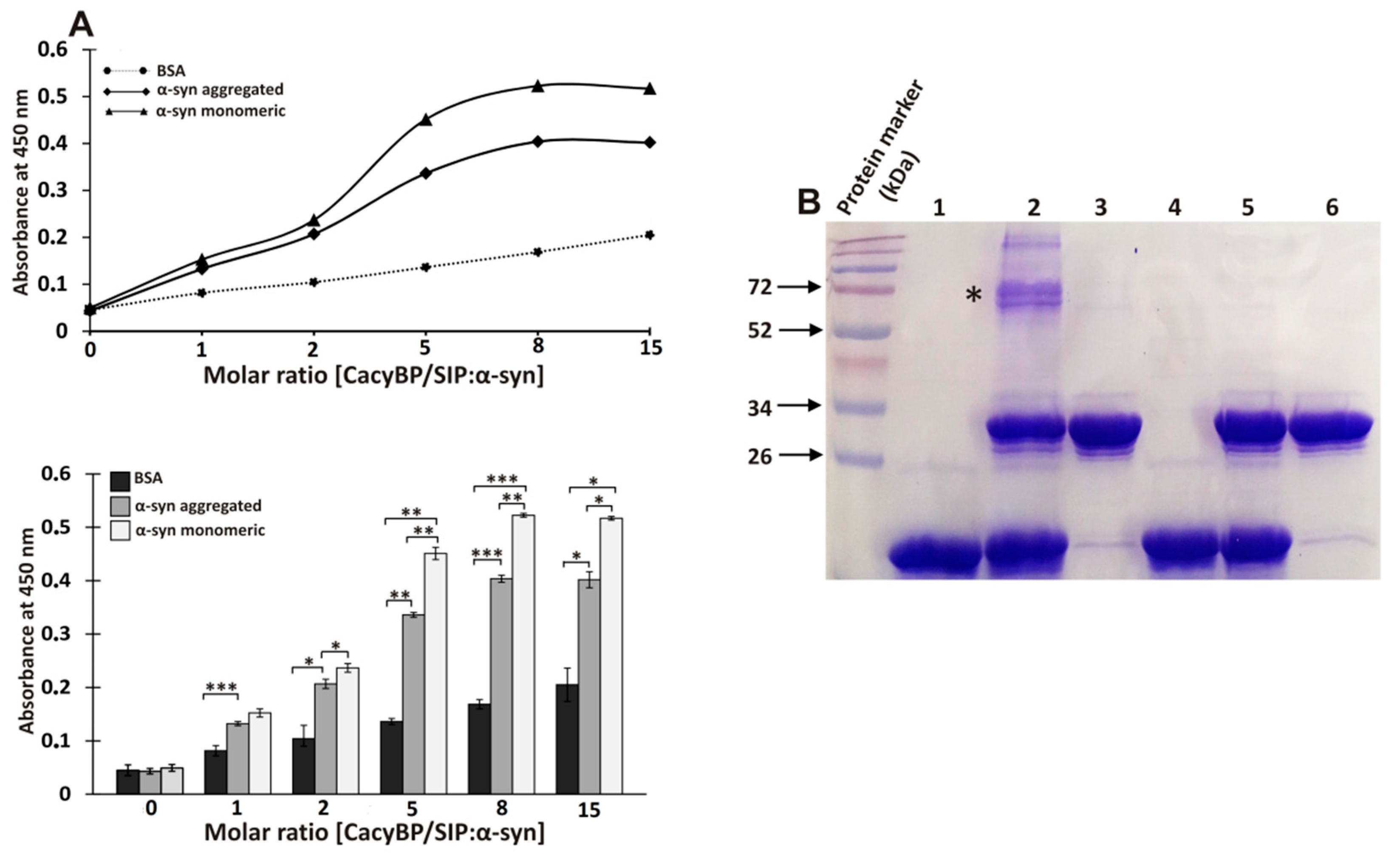

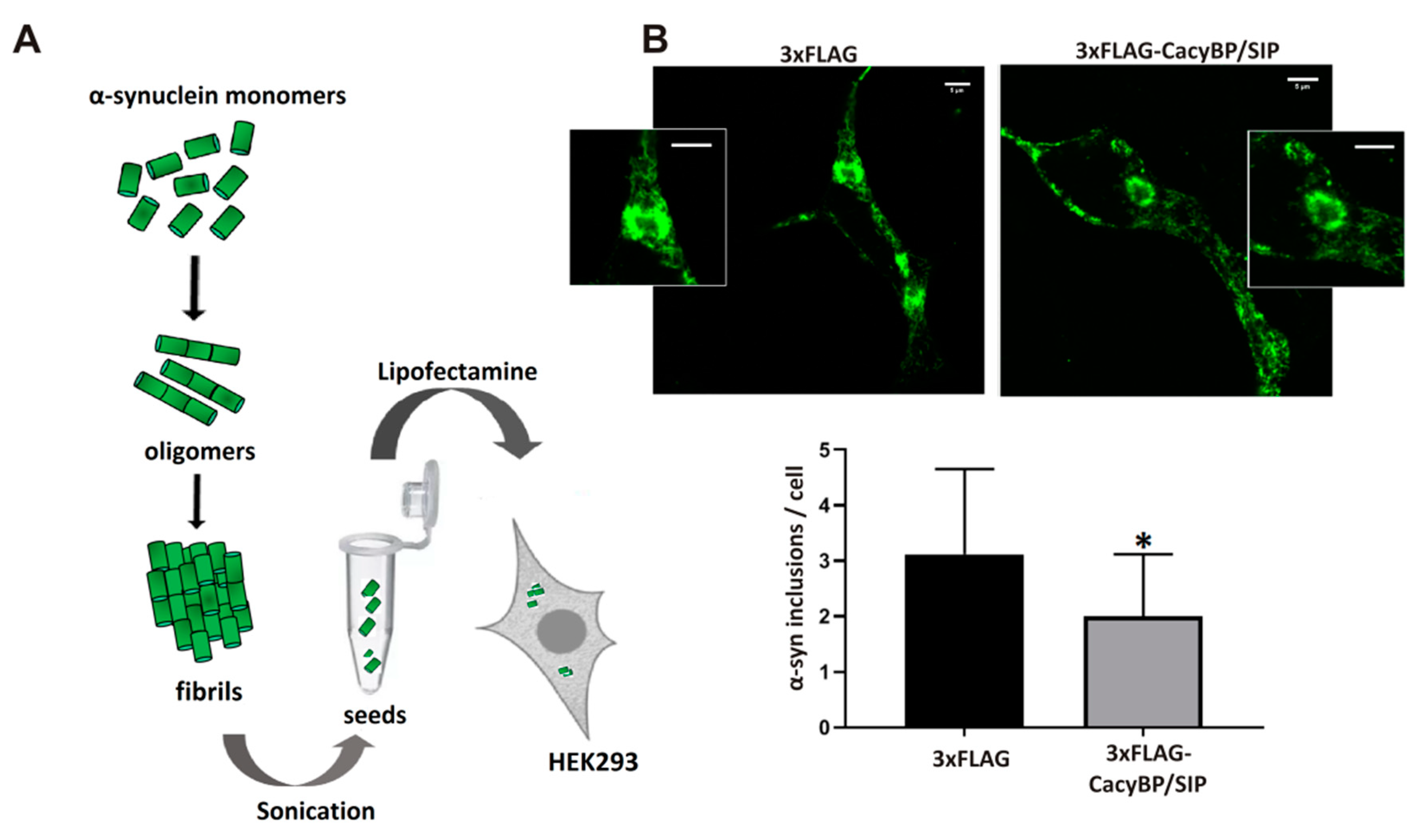

| Plasmid | Description | Source/Reference |
|---|---|---|
| pET28a | plasmid for protein expression in E. coli under the T7 promoter encoding protein with 6xHis tag | Novagene |
| pET28a-CacyBP/SIP | plasmid encoding CacyBP/SIP with 6xHis tag | [27] |
| pET28a-CacyBP/SIP 1–77 | plasmid encoding N-terminal (N) domain (residues 1–77) of CacyBP/SIP with 6xHis tag | [27] |
| pET28a-CacyBP/SIP 74–178 | plasmid encoding middle (CS) domain (residues 74–178) of CacyBP/SIP with 6xHis tag | [27] |
| pET28a-CacyBP/SIP 178–229 | plasmid encoding C-terminal (SGS) domain (residues 178–229) of CacyBP/SIP with 6xHis tag | [27] |
| pET28a-CacyBP/SIP 1–178 | plasmid encoding fragment of CacyBP/SIP covering N-terminal (N) and CS domains (NCS; residues 1–178) of CacyBP/SIP with 6xHis tag | [27] |
| pET28a-α-synuclein | plasmid encoding α-synuclein with 6xHis tag | present work |
| p3xFLAG-CMV-10 | plasmid for protein expression in eukaryotic cells encoding 3xFLAG tag | Sigma-Aldrich |
| p3xFLAG-CMV-10 -CacyBP/SIP | plasmid for protein expression in eukaryotic cells encoding 3xFLAG-CacyBP/SIP | [20] |
| pcDNA4-α-synuclein-3xFLAG | plasmid for protein expression in eukaryotic cells encoding α-synuclein-3xFLAG | U. Dettmer, Harvard Medical School, Boston, USA |
© 2020 by the authors. Licensee MDPI, Basel, Switzerland. This article is an open access article distributed under the terms and conditions of the Creative Commons Attribution (CC BY) license (http://creativecommons.org/licenses/by/4.0/).
Share and Cite
Bohush, A.; Filipek, A. HSP90 Co-Chaperone, CacyBP/SIP, Protects α-Synuclein from Aggregation. Cells 2020, 9, 2254. https://doi.org/10.3390/cells9102254
Bohush A, Filipek A. HSP90 Co-Chaperone, CacyBP/SIP, Protects α-Synuclein from Aggregation. Cells. 2020; 9(10):2254. https://doi.org/10.3390/cells9102254
Chicago/Turabian StyleBohush, Anastasiia, and Anna Filipek. 2020. "HSP90 Co-Chaperone, CacyBP/SIP, Protects α-Synuclein from Aggregation" Cells 9, no. 10: 2254. https://doi.org/10.3390/cells9102254
APA StyleBohush, A., & Filipek, A. (2020). HSP90 Co-Chaperone, CacyBP/SIP, Protects α-Synuclein from Aggregation. Cells, 9(10), 2254. https://doi.org/10.3390/cells9102254





